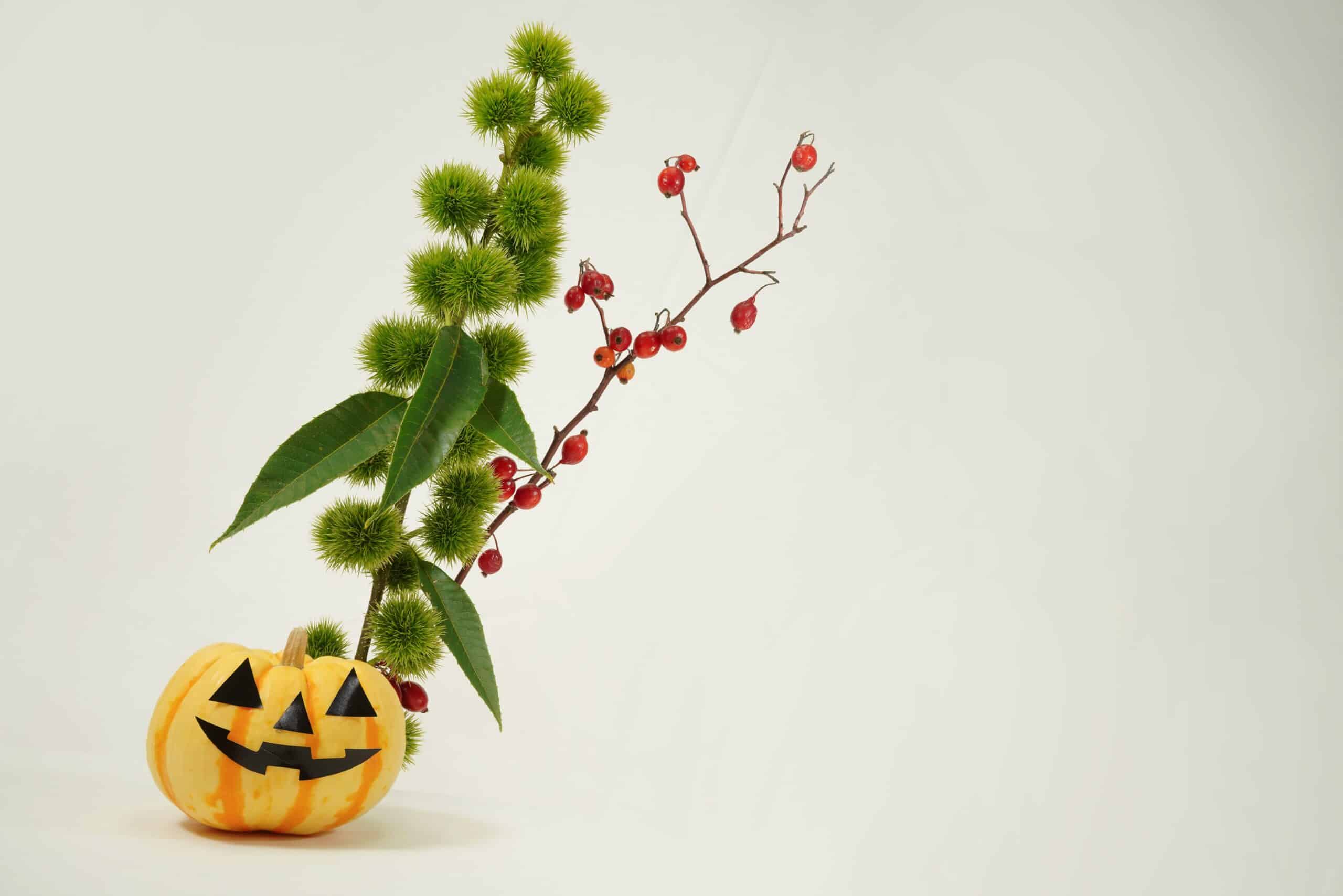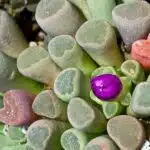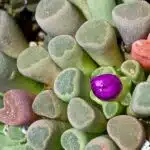Have you ever seen something so beautiful that it’s almost otherworldly? That’s exactly what the Ghost Plant – or Graptopetalum paraguayense – is. Its leaves are almost translucent, like they’re made of glass! Its white, pastel pink, and green colors make this succulent plant look like it’s from a dream. It’s perfect for adding a touch of ethereal beauty to any garden or home.
If you’ve been dreaming of having a Ghost Plant of your own, then you’re in luck! Growing and caring for this succulent is surprisingly easy. All it takes is some sunshine, water, and soil to get started. With just a few simple steps, you’ll be able to nurture your very own ghostly creation.
So let your imagination run wild as we explore how to grow and care for the stunning Graptopetalum paraguayense – the mysterious Ghost Plant! With our help, you’ll be able to bring a little bit of the supernatural into your garden.
What Is A Ghost Plant?
Ghost Plant is a unique succulent that has gained popularity in recent years for its unusual appearance. Its leaves are gray-green, with a powdery coating that gives them a ghostly look. It’s easy to care for and is great for people who like low-maintenance plants. The plant grows slowly and can reach up to three feet tall, making it an interesting addition to any home or garden.
Although it’s native to South Africa and Namibia, the Ghost Plant is easy to grow indoors in most climates. It needs bright indirect light, regular watering (once every one to two weeks), and well-draining soil. The soil should be allowed to dry out completely between waterings and fertilized every other month during the growing season. With proper care, this unique succulent will bring lots of color and interest into your living space or garden.
Ghost Plant is a fun choice for both experienced gardeners as well as those just getting started with indoor plants. It’s low maintenance nature makes it a great addition to any home or outdoor area where you want something that stands out from the rest while still being easy to take care of. With its soft colors and interesting texture, this eye-catching succulent is sure to add character and charm to any environment. Now that you know more about the ghost plant, let’s look at where it grows best!
Where Does The Ghost Plant Grow?
Ghost plants are an interesting succulent that make for great houseplants. Native to Mexico, they offer a unique look with their small, tightly packed leaves and light gray-green foliage. But where does the ghost plant grow? Let’s take a closer look at this succulent and understand what environment is ideal for its growth.
Ghost plants can be found growing in rocky soils in mountainous areas of central Mexico. They prefer warm climates, full sun and well-drained soil with some organic matter mixed in. If planted outdoors, it’s best to choose an area with some protection from cold winter winds and frosts. Indoors, place them in a bright location away from direct sunlight during the hottest hours of the day.
With their modest needs for water and sun, ghost plants are well suited to many different environments. While they’re not fussy about soil type, there are certain components that will help them thrive – making sure their roots have access to oxygen while also providing adequate drainage and moisture retention is key. What soil is ideal for growing ghost plants?
What Soil Is Ideal For Growing Ghost Plants?
Ghost plants are a unique, beautiful succulent that can add the perfect touch to any indoor or outdoor space. A captivating addition, this plant is sure to make your garden stand out! But before you consider adding one of these ethereal plants to your garden, there are some important considerations. One such consideration is soil: what is the best soil for growing ghost plants?
When it comes to soil, you want to choose something with excellent drainage and air permeability so that the roots don’t become waterlogged. You should also avoid soils that contain too much clay as this will inhibit oxygen from reaching the roots. A good potting mix or cactus mix should do the trick. If you find commercial mixes lacking in nutrition, you can always supplement with perlite or pumice for better aeration and drainage.
By selecting a well-draining soil blend for your ghost plant, you create an optimal environment for growth and health. With a tailored soil blend in place, your ghost plant will be well on its way towards thriving health and beauty! But not all environmental factors are created equal; light conditions are just as important when it comes to caring for a ghost plant.
What Light Conditions Are Best For Ghost Plants?
To keep a ghost plant happy and healthy, the right light conditions are essential. They require bright and filtered light, such as indirect sunlight or diffused light from growing indoors near a window. Ghost plants can also tolerate some shade, but they won’t be as vibrant if they don’t get enough sun.
When it comes to lighting for ghost plants, it’s important to find a balance between too much and not enough. Too much direct sunlight can cause the leaves to burn, while too little light will result in the plant stretching out in search of more.
The good news is that you don’t need to worry about complicated lighting setups for your ghost plant. Just make sure it gets plenty of bright light without any burning from direct sunlight, and it should be happy!
How To Water Ghost Plants
Watering is one of the most important aspects of ghost plant care. According to a survey, 70% of succulent owners get it wrong. This statistic shows how imperative it is to learn the right way to water these plants to keep them healthy and thriving.
The key to watering ghost plants is consistency, frequency, and moderation. You should water your plants whenever the soil feels dry (which can be up to two weeks depending on the conditions). When you do water your ghost plant, make sure that you give it a thorough soak at least once a week in order for the soil to become completely saturated. Over-watering can cause root rot, which is why it’s essential to let the soil dry out between waterings and not leave any standing water in the pot.
To ensure that you don’t over-water your ghost plant, check the moisture level of the soil with your finger or a moisture meter before watering. If you’re still unsure about whether or not your plant needs more water, err on the side of caution and wait until it looks like it needs more before giving it more. It’s also important to make sure that you’re using pots with drainage holes so that excess water can drain away from the roots. By following these tips, you’ll be able to keep your ghost plant happy and healthy!
With proper watering techniques in place, propagating your ghost plant will be much easier and successful!
How To Propagate Ghost Plants
Propagating succulents is like baking a cake: it can be a tricky process, but when done right, the results are beautiful and rewarding. Ghost plants are no exception. Fortunately, with some patience and effort, you can easily propagate a ghost plant in your own home.
Propagation involves taking a cutting of the succulent’s stem or leaves to create new plants. To do this, start by selecting healthy-looking stems or leaves from your existing plant. Make sure to choose stems that don’t have any signs of rot or insects on them. Make sure to remove any dead or damaged material from the stem before cutting it into several sections (3-4 inches long). Place each section in its own pot filled with cactus soil and place it in an area with indirect sunlight.
Once your cuttings have been placed in their pots, keep the soil moist but not overly wet; check for moisture every few days by sticking your finger into the soil up to your knuckle. Your cuttings should take root within 4-6 weeks if kept moist and given enough light—you’ll know when they’re ready for transplanting when you see new growth emerging from the stem!
With just a bit of effort and care, you’ll soon be rewarded with brand new plants that have grown out of one single succulent!
How To Avoid Common Pests And Diseases
Preserving your ghost plant can be a rewarding experience! With the right care and attention, you can ensure that your ghost plant stays beautiful and healthy. Here are some tips to help you avoid common pests and diseases.
First of all, good air circulation is key for keeping any succulent healthy. Be sure to provide plenty of airflow around your ghost plant by pruning it regularly and spacing out other plants nearby. This will reduce the risk for fungal diseases like powdery mildew or root rot.
Secondly, make sure the soil you use for planting has excellent drainage. Poorly draining soil will cause waterlogging, which can lead to root rot or other fungal issues. Additionally, it’s important to check the soil moisture frequently—if it becomes too dry or too wet, that could also increase the risk of diseases and pests.
To further protect your ghost plant from potential dangers, here are some quick action items: • Monitor the environment—ensure humidity levels are low and temperatures aren’t too extreme • Remove any dead leaves or stems as soon as possible • Take preventative measures like using neem oil sprays • Regularly check for signs of pests like mealybugs or spider mites
By taking these steps and monitoring your ghost plant closely, you should be able to keep it in great shape over time!
How To Fertilize Ghost Plants
Fertilizing ghost plants can be like music to their succulent leaves – a delicate balance of nutrients that keeps them thriving. When it comes to feeding these unique plants, there are three main points to keep in mind: • Use a diluted liquid fertilizer – no more than 25% strength – once every other month during the growing season • Avoid using any fertilizer during the winter months when the plant is dormant • Don’t over-fertilize, as this can burn and damage the roots These simple tips will help ensure your ghost plant stays healthy and happy.
When it comes to fertilizing your ghost plant, you must be careful not to overdo it. Too much fertilizer can cause root rot and other damage. Start by diluting liquid fertilizer to no more than 25 percent strength and use it only once every two months during the growing season. Don’t forget that your ghost plant needs a break during winter months, so hold off on fertilization until spring arrives.
When used properly, fertilizer will give your ghost plant the nutrition it needs for optimal growth. Just remember that moderation is key – too little or too much can have negative effects on its health. By following these tips, you’ll be able to provide your ghost plant with just the right amount of food, allowing it to thrive for years to come! Transitioning into the next step: when it’s time to repot your ghost plant for even greater success!
When To Repot Ghost Plants
When it comes to repotting ghost plants, timing is everything. A well-timed repot can help ensure healthy growth and beautiful blooms. But if done too soon or too late, it can cause serious damage and even kill your beloved succulent. So how do you know when the time is right?
There are several signs that indicate it’s time to repot. The first is when roots come through the drainage holes of the pot. This usually happens within six months of planting in a pot with good soil, although it could take up to two years depending on conditions such as humidity or water levels. When roots appear in this way, they’re telling you they need more space to expand and grow.
Another sign that you need to repot is when the plant seems crowded in its current container, with leaves growing out the sides instead of up. Crowding can lead to root rot which will eventually kill your plant—so if you see this happening, be sure to act quickly by gently removing the plant from its pot and replanting in a larger one with fresh soil.
Repotting at just the right time will give your ghost plant an extra boost for healthy growth and beautiful blooms for years to come. Now that you know when it’s time to repot, let’s look at how to overwinter these special succulents properly.
How To Overwinter Ghost Plants
During the cold winter months, many gardeners are left wondering how to keep their beloved ghost plants alive. For example, one gardener may have a particularly large plant that has been thriving for years, and worry about how to properly overwinter it. Fortunately, overwintering ghost plants is relatively easy.
The first thing to do when overwintering a ghost plant is to reduce the amount of water it receives. These plants prefer dry soil in the winter months, so watering should be done sparingly—about once every 2-3 weeks at most. It’s also important to move the plant indoors if temperatures drop below 40 degrees Fahrenheit. If this isn’t an option, then providing some sort of translucent cover may help protect against extreme temperatures and harsh winds. Additionally, it’s recommended that you use a potting mix specifically designed for succulents when repotting your ghost plant during the winter season—this will provide extra protection against frost damage while still allowing enough drainage for healthy root growth.
Finally, it’s essential to inspect your ghost plant regularly throughout the overwintering process. Look for signs of rot or disease on the leaves and stems and take action accordingly—either by pruning away affected areas or applying fungicide if necessary. With proper care and attention, your ghost plant can easily survive even the harshest winters!
What To Do When Ghost Plants Look Unhealthy
It’s like a ghost plant is the plant version of a shy person. When it’s not taken care of properly, it will start to fade away from sight. That’s why it’s so important to know how to make sure your ghost plants stay healthy and vibrant.
Just like any other succulent, ghost plants need lots of light, water, and nutrients to stay healthy. But they do have some extra special needs that must be met in order for them to thrive. These include proper drainage in their potting mix and protection from cold temperatures during winter months.
Sometimes even with the best care, ghost plants can become unhealthy or suffer from pests or disease. If this happens, you should remove any dead or diseased leaves or stems from the plant as soon as possible. You should also inspect any new growth for signs of pest infestation and take steps to eradicate them if needed. Additionally, you may want to add additional fertilizer or supplement the soil with some additional nutrients in order to give the plant a boost when it looks unhealthy.
These simple steps will help ensure your ghost plants stay healthy and strong throughout the year so that they can continue their mission of bringing beauty into your garden!
How To Design A Succulent Garden With Ghost Plants
Designing a succulent garden with ghost plants is a great way to add vibrancy and life to any outdoor space. It can also be an easy way to create low-maintenance beauty that endures year-round. To get started, you’ll need to have the right soil and potting mix, appropriate lighting, and an understanding of how to care for the plant.
When considering where to place the ghost plant in your garden, it’s important to remember that this succulent does best in partial shade or indirect sunlight. As such, try not to place it in direct sun as this may lead to burning or fading of the leaves. Additionally, you’ll want to use well-draining soil so that your ghost plant doesn’t become waterlogged. You may also want to consider adding some organic material like compost or peat moss into your potting mix for added nutrition and moisture retention.
When it comes time to arrange your succulent garden, there are a few things you should keep in mind. First, be sure to leave enough room between each plant so they can grow without overcrowding one another. Also, if you’re planning on creating a more intricate design with multiple species of succulents, make sure each type has its own designated area where it won’t take nutrients from other types of plants around it. Finally, pay attention when selecting other plants for your garden; avoid choosing those that require more maintenance than your ghost plants do or those with different light requirements than what yours require.
By following these tips while designing your succulent garden with ghost plants, you can ensure that both the aesthetics and health of your garden remain beautiful and strong long after planting is complete!
How To Prune Ghost Plants
“A stitch in time saves nine”. This old adage is a reminder that proper pruning is essential for the health of your ghost plant. Pruning helps to stimulate growth, encourage flowering, and can also help to keep your plant looking its best.
If you’re new to pruning succulents, don’t worry! It’s a simple process that doesn’t require any special tools or skills. The most important thing to remember is that you should always use clean, sharp shears when pruning. This will help to ensure that the cuts are smooth and even, allowing the plant to heal quickly and evenly.
When it comes to pruning ghost plants, there are two main approaches: thinning and deadheading. Thinning involves removing old stems and leaves that have become too large or overgrown for the plant’s health – this can help to improve air circulation as well as promote new growth. Deadheading is more focused on maintaining the aesthetic of your ghost plant – simply snipping off any dead blooms or browned leaves will not only make your plant look better but will also allow it to focus its energy on growing healthier foliage and blooms instead of wasting energy on dead material.
With these techniques in mind, you’ll be able to keep your ghost plants looking their best while giving them the care they need to thrive! Next up: learning how to decorate with ghost plants for an eye-catching display!
How To Decorate With Ghost Plants
The possibilities for decorating with ghost plants are truly endless! From adding a few sprigs along the windowsill to creating an entire wall of vibrant succulents, these unique little plants can serve as a stunning backdrop to any room. And, if you’re looking for something even more daring, why not create an eye-catching centerpiece by arranging several ghost plants in a beautiful terracotta pot? With a little ingenuity and creativity, you can use these gorgeous succulents to turn your home into a verdant oasis.
Decorating with ghost plants doesn’t have to be complicated either. All it takes is just a few simple steps and you’ll be able to create the perfect look that’s sure to wow your guests. Start by selecting the perfect pot or container for your succulent masterpiece – terracotta and ceramic are great choices for this – then begin arranging your ghost plants according to size and shape. Add some colorful rocks or sand for texture, and don’t forget to place some drainage holes at the bottom so excess water can escape.
Finally, give your masterpiece that extra special touch by adding some accessories like ribbons, twine, and seashells. You can also get creative with paint and stencils if you really want to take things up a notch. With just a bit of effort, you’ll soon have an amazing display that will instantly transform any space into something truly unique!
How To Care For Ghost Plant Leaves
Caring for ghost plant leaves isn’t difficult, but it does require a few specific steps. This succulent is known for its striking purple color, and keeping its leaves healthy is key to maintaining its vibrant hue. Here’s what you need to know to preserve the beauty of your ghost plant:
- Make sure the soil it’s in drains well, as these plants don’t appreciate standing water.
- Provide plenty of direct sunlight – this succulent loves it!
- Water only when the top layer of soil has dried out; otherwise, you’ll risk overwatering and damaging the leaves.
With a little TLC, your ghost plant will continue to dazzle with its eye-catching appearance. Applying these three tips will ensure your succulent stays healthy and looking great for years to come! Plus, if you find yourself with extra leaves or cuttings from pruning, you can use them in decorating projects around your home and garden – how fun! Caring for ghost plant leaves doesn’t have to be intimidating; just follow these simple steps and you’ll be rewarded with a beautiful plant that will last for years!
Frequently Asked Questions
How Do I Know When My Ghost Plant Needs More Light?
Have you ever wondered how to know when your ghost plant needs more light? This is an important question for anyone who owns this succulent, as the amount of light it receives can affect its growth. To make sure that your ghost plant is receiving the proper amount of light, it’s important to understand what kind of lighting it needs and when to provide it.
Ghost plants, also called Graptopetalum paraguayense, are a type of succulent that requires plenty of bright light in order to thrive. They prefer direct sunlight during the early morning hours and some shade during the hottest parts of the day. If you notice that your ghost plant is beginning to look pale green or yellowish, then it may need more light. It’s also possible that it isn’t getting enough water; if so, its leaves will become shriveled and dry-looking.
If you’re unsure whether your ghost plant needs more light or not, there are a few ways to tell. One way is to move the pot closer to a window and monitor how the leaves respond over time. If they start looking healthier within a few days or weeks, then your ghost plant was probably not getting enough light before. Another way is to give it some extra sunlight and watch for signs of stress like wilting leaves or sunburned areas on the leaves – this could mean that it’s getting too much light and should be moved back into indirect sunlight or placed under a shade cloth.
By understanding what kind of lighting your ghost plant needs and how to tell if it’s not getting enough or too much, you can ensure that your succulent stays healthy and grows properly! With just a bit of care and attention, you can keep your ghost plant thriving for years to come!
What Type Of Fertilizer Is Best For Ghost Plants?
Ghost plants, also known as Graptopetalum paraguayense, are a type of succulent that add an interesting texture to any garden. When it comes to caring for a ghost plant, fertilizer is essential. But what kind of fertilizer should you use?
The best type of fertilizer to use on ghost plants is a balanced 10-10-10 fertilizer with trace elements. This will provide your ghost plant with the right amount of nitrogen, phosphorus and potassium for healthy growth. You should apply the fertilizer once every few weeks during the growing season and less often when the plant is dormant. Additionally, using a slow-release or liquid fertilizer can help reduce nutrient leaching from the soil.
It’s important to remember not to overfertilize your ghost plant as this can lead to damage and even death. Always read the instructions on the package carefully before applying any fertilizer and never fertilize a dry soil as this can burn your plant’s roots. Finally, make sure you water before and after fertilizing for optimal results. With these tips in mind, you’ll be well on your way to having a thriving ghost plant in no time!
Are There Any Particular Pests Or Diseases I Should Be Aware Of When Caring For Ghost Plants?
When it comes to caring for Ghost Plants, one must be aware of the potential pests and diseases that may arise. From mildew to root rot, there are a variety of threats that can affect Ghost Plants if proper precautions aren’t taken. To ensure the health of your plant, it’s important to become familiar with common pests and diseases associated with this succulent.
To start off, let’s take a look at the signs and symptoms of some common illnesses in Ghost Plants. For example, you may see yellow or white spots on the leaves that indicate powdery mildew, while root rot is often characterized by browning or blackening at the base of your plant. In addition to these issues, there are also certain pests that can target Ghost Plants such as mealybugs and aphids.
To keep your plant healthy and protected against any potential problems, there are several steps you can take:
Prevention:
Inspect plants regularly for signs of disease or damage
Prune dead or damaged leaves and stems
Ensure adequate air circulation around your plants
Treatment:
Remove affected parts from the plant using sterilized scissors
Treat affected areas with fungicide or insecticidal soap
Monitor plants closely after treatment to ensure no further damage occurs
Taking these small preventative measures can help keep your Ghost Plant in great shape for years to come. Knowing how to recognize potential problems early on will save you time and money in the long run as well as give you peace of mind knowing your plant is getting the best care possible!
How Often Should I Water My Ghost Plant?
When it comes to caring for a Ghost Plant, one of the most important factors is making sure you’re providing the right amount of water. Too much or too little can quickly kill this delicate succulent. But how often should you water your Ghost Plant?
The answer depends on several factors, including the size of the pot, the type of soil used, and your local climate. Generally speaking, you should water your Ghost Plant deeply but infrequently to prevent root rot. This means watering once every two to four weeks during growing season and even less frequently during the dormant season. You should also allow the soil to dry out completely between each watering session.
If you live in a hot or dry region where temperatures tend to stay above 70 degrees Fahrenheit for most of the year, then consider misting your Ghost Plant with a spray bottle filled with filtered or distilled water. Doing so will help keep its leaves hydrated without over-saturating its roots. Additionally, be sure that your container has adequate drainage holes at the bottom to prevent pooling and rotting. With proper care and attention, your Ghost Plant will thrive!
Is There A Particular Time Of Year When I Should Repot My Ghost Plant?
Repotting your ghost plant at the right time of year can ensure it continues to thrive. Although it is a succulent and doesn’t need frequent watering or fertilizing, repotting your ghost plant every two to three years will give it the best chance for healthy growth. But when exactly should you repot?
When considering when to repot your ghost plant, you should consider the climate where you live and the season. The best time of year to repot your ghost plant is during its dormant period—usually in late winter or early spring before new growth begins. This is because the root system of your ghost plant will be less active during this period, making it easier to handle during repotting.
Before you start, make sure that the pot and soil you use are suitable for your ghost plant. Choose a new pot with drainage holes and fill it with cactus potting mix or a combination of sand and soil. Once you’ve planted your succulent in its new home, remember not to water it too frequently—only once every one to two weeks during its growing season (late spring through summer). Doing so will help keep your ghost plant healthy and happy!
Conclusion
The care of a Ghost Plant is not difficult, but it does require some knowledge of the plant’s needs. Knowing when and how much light to give your plant, what type of fertilizer to use, and how often to water are all important considerations. Additionally, being aware of any pests or diseases that may affect your Ghost Plant is essential for keeping it healthy and thriving. Finally, repotting your Ghost Plant at the right time can help ensure that it continues to grow properly and that its roots don’t become too crowded.
With proper care, your Ghost Plant can thrive and provide you with many years of beauty. By using the techniques outlined in this article – paying attention to lighting needs, using the appropriate fertilizer, regularly checking for pests or disease, watering on a schedule, and repotting at the proper time – you can ensure that your plant remains healthy and happy.
Ultimately, as long as you take good care of your Ghost Plant by providing it with adequate light, nutrition, water and space to grow in its pot – you will be rewarded with lush foliage for many years.





























